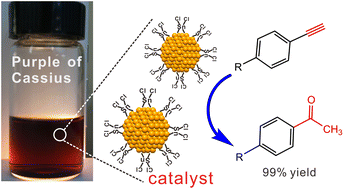Role of Au–Sn bonding for stabilizing a gold nanocatalyst: a reinvestigation of purple of Cassius†
Abstract
Purple of Cassius is a pigment based on a gold colloid that has been known for hundreds of years. It has had a profound influence on modern nanoscience. But the origin of the small size of the Au nanoparticles (NPs) and their superior stability remains ambiguous. The experiments and characterization studies discussed here confirmed that SnCl2 functioned not only as a reducing agent but also as an effective surface capping agent through bimetallic Au–Sn bonding. This finding expands the types of Au NP stabilizer from traditional organic examples (e.g., thiolate or phosphine) to metallic examples. The formation of a Au–Sn interface also endows Au NPs with excellent activity and separability for the hydration of alkynes to ketones.



 Please wait while we load your content...
Please wait while we load your content...